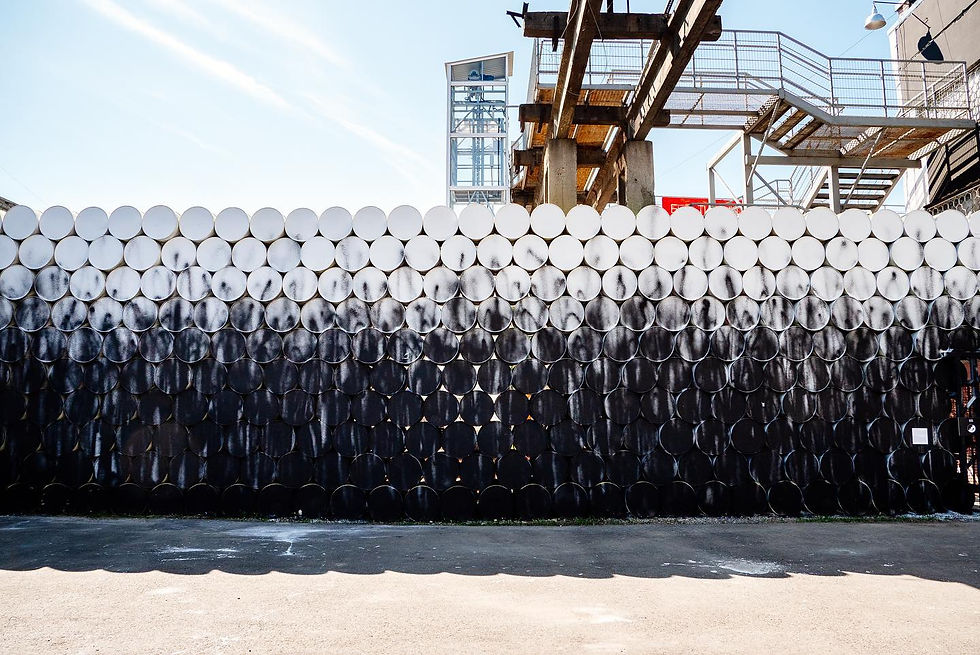A Study in Shapes That Elude Meaning
- Tom Denman

- Sep 12, 2023
- 4 min read
Updated: May 20

In Where Light No Longer Names the Shape, currently on view at Art Gallery 13 in Bishop’s Stortford, Kamil Kaplan undertakes a measured withdrawal from the luminous assertiveness of his earlier formal language and steps into a newly rarefied terrain—one defined less by revelation than by recession. Curated with quiet restraint by Ieva Bendžiūtė, the exhibition presents a sequence of sculptural paintings—painstakingly constructed from resin and layered plexiglass—that enact a slow unravelling of form, perception, and the semiotic pact between light and meaning.
Kaplan has long situated himself at the intersection of optical phenomenology and sacred geometry, often invoking light not only as a medium but as a quasi-theological signifier. Yet in this new body of work, light no longer functions as a clarifying force. It becomes oblique, distended, melancholically inert. The panels do not glow, nor do they illuminate—they murmur. Their chromatic register—once sharply delineated and ritualistically composed—has dissolved into hazy recessions, veils of synthetic pastels and spectral residue. The result is a perceptual condition in which light ceases to define shape and instead retreats from the act of naming altogether.
The implications of this retreat are as epistemological as they are aesthetic. The title itself—Where Light No Longer Names the Shape—articulates a crisis of legibility. Light, here, is not a revealer but a dissolver. Shape is no longer an object of cognition but a phenomenon of delay. The gaze is drawn into recursive planes of barely perceptible depth, only to encounter structures that refuse to settle into fixed meaning. These are not illusions, nor symbols, but spaces of suspension—phenomena that inhabit the threshold between appearance and disappearance.
In this sense, Kaplan’s most recent works share an unexpected affinity with the late dramaturgy of Samuel Beckett. Like Quad (1981) or Footfalls (1976), Kaplan’s panels reduce form to the point of vanishing, while retaining a charged existential residue. In Beckett’s diminished theatrical worlds, presence is always under erasure; figures appear only to vanish, and movement becomes less an act of progression than a circular rehearsal of futility. Kaplan’s geometries operate in a similar register. The squares, corridors, and vanishing planes etched into his resin surfaces do not guide the eye towards clarity, but choreograph it into closed circuits of deferral and return. As with Beckett’s protagonists, the viewer is suspended in a spatial predicament that offers no resolution—only repetition, and the sediment of a failed gesture.
This phenomenological recursion is intensified by Kaplan’s material choices. Resin and plexiglass—industrial media typically associated with clarity and technological precision—are rendered here as diffuse, spectral. These works are not immaterial, but neither are they fully present. Their surfaces are too smooth to anchor the eye, too translucent to grasp. In an age dominated by hyper-visibility and incessant image culture, Kaplan proposes instead a practice of visual reticence. He does not present—he withholds. The shape no longer declares itself; it hesitates.
What unfolds is a spatial and perceptual ethos deeply in dialogue with Beckett’s poetics of failure—what literary theorist Steven Connor has termed “the exhausted image,” in which repetition and loss comprise the structural conditions of meaning. In Kaplan’s work, the repetition is not linguistic but architectural. One piece, composed of concentric forms in anaemic neon hues, stages a geometry that folds endlessly inward—yet never concludes. Another offers the illusion of a corridor, a soft chromatic gradient that hints at depth but flattens, on approach, into a fog of unresolved colour. These are shapes that remember their own erosion, forms that persist only as traces of what they once sought to contain.
There is also a psychological register to this Beckettian correspondence. Kaplan’s panels operate as memory-chambers, architectural recesses that defy naming precisely because they behave like forgotten dreams: vivid yet inaccessible, present yet dissolving. The longer one stands before them, the more they seem to recede—not spatially, but in certainty. This is the aesthetic of the ungraspable: works that exist in the afterglow of their own retreat, much like Beckett’s Not I—where the voice persists, even as the meaning vanishes.
Bendžiūtė’s curatorial approach is aptly ascetic. She does not attempt to narrativise Kaplan’s drift into indeterminacy. Instead, the exhibition is staged as a phenomenological encounter. There are no wall texts, no contextualising labels—only space, silence, and the works themselves. The white cube becomes a site of potential disorientation, recalling not the museum but the chamber, the sanctum, the Beckettian nowhere. The visitor is left, as Beckett puts it, to "go on failing" at the act of seeing. And in that failure, something is revealed—not through explanation, but through attenuation.
What Kaplan achieves in Where Light No Longer Names the Shape is not a rejection of meaning, but a reconfiguration of its temporality. Meaning, here, is not imminent; it is deferred, exhaled across time, or altogether lost. This is an art of uncertain thresholds, where perception itself becomes a metaphysical condition. To stand before these works is to encounter Beckett’s dictum: "the shape will not hold." And in that collapse, a new mode of attention is born—one rooted not in knowledge, but in proximity. In the shadow of meaning. In the refusal to resolve.
Kamil Kaplan, Where Light No Longer Names the Shape
Art Gallery 13, 5 Ducketts Wharf, South Street, Bishop’s Stortford, United Kingdom, CM23 3AR
Curated by Ieva Bendžiūtė
11 September – 13 October 2023
Tom Denman, residing in London, is a distinguished freelance art critic whose perceptive articles have featured in eminent publications such as Art Journal, ART PAPERS, ArtReview, Art Monthly, Burlington Contemporary, e-flux, Flash Art, Ocula, and Studio International. He earned his PhD in Italian Studies from the University of Reading, focusing his research on Caravaggio and the noble-intellectual milieu of seventeenth-century Naples. Presently, his critiques primarily explore the subtleties and emerging trends within contemporary art.










Comments